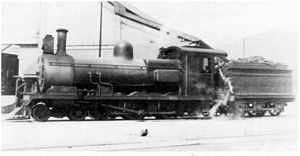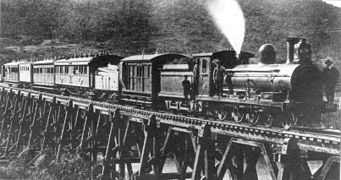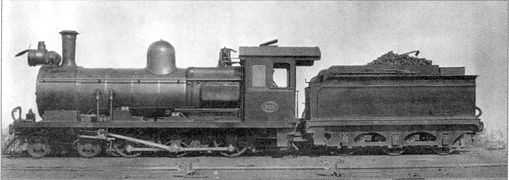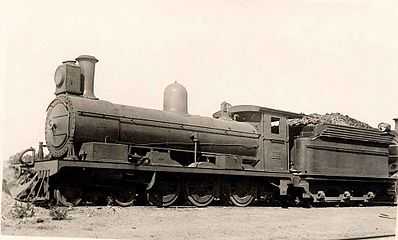CGR 5th Class 4-6-0 1891
| CGR 5th Class 4-6-0 1891 to South African Class 05 4-6-0 1891 | |
|---|---|
|
CGR 5th Class 4-6-0 no. 122, SAR no. 0122, c. 1920 | |
| Type and origin | |
| Power type | Steam |
| Designer | Cape Government Railways |
| Builder | Dübs and Company |
| Serial number | 2712-2741 |
| Build date | 1891 |
| Total produced | 30 |
| Specifications | |
| Configuration | 4-6-0 "Tenwheeler" |
| Gauge | 3 ft 6 in (1,067 mm) Cape gauge |
| Leading wheel diameter | 28 in (711 mm) |
| Driver diameter | 49 in (1,240 mm) |
| Wheelbase |
10 ft (3.048 m) coupled 5 ft (1.524 m) bogie 19 ft 1 3⁄8 in (5.826 m) engine 10 ft (3.048 m) tender 40 ft 2 3⁄8 in (12.252 m) total |
| Length | 48 ft 1 3⁄4 in (14.675 m) over couplers |
| Height | 12 ft 1 1⁄2 in (3.696 m) |
| Locomotive weight | 38 6⁄20 long tons (38.9 t) w/o |
| Tender weight | 28 11⁄20 long tons (29.0 t) w/o |
| Locomotive and tender combined weight | 66 17⁄20 long tons (67.9 t) w/o |
| Tender type |
Three-axle 37 inches (940 mm) wheels |
| Fuel type | Coal |
| Fuel capacity | 4 long tons (4.1 t) |
| Water capacity | 1,950 imp gal (8,900 l; 2,340 US gal) |
| Boiler |
4 ft (1.219 m) inside diameter 11 ft 1 7⁄8 in (3.400 m) length inside 6 ft 4 1⁄2 in (1.943 m) pitch |
| Boiler pressure | 150 psi (1,000 kPa) |
| Firegrate area | 16.18 sq ft (1.503 m2) |
| Heating surface: – Tubes |
185 tubes 1 3⁄4 in (44.4 mm) diameter 946.32 sq ft (87.916 m2) |
| – Firebox | 90.96 sq ft (8.450 m2) |
| – Total | 1,037.28 sq ft (96.366 m2) |
| Cylinders | Two |
| Cylinder size |
16 in (406 mm) bore 24 in (610 mm) stroke |
| Valve gear | Stephenson |
| Performance figures | |
| Tractive effort | 14,110 lbf (62.8 kN) at 75% pressure |
| Career | |
| Operator(s) |
Cape Government Railways OVGS New Cape Central Railway Imperial Military Railways Central South African Railways South African Railways |
| Class | CGR 5th Class, SAR Class 05 |
| Number in class | 30 |
| Number(s) |
Eastern 55-58 Midland 136-138 & 309-314 Western 117-118, 121-135 |
| Delivered | 1891 |
| First run | 1891 [1] |
| Withdrawn | 1953 [2] |
The CGR 5th Class 4-6-0 of 1891 is a South African steam locomotive from the pre-Union era in the Cape Colony.
In 1891 the Cape Government Railways placed a second batch of thirty 5th Class tender locomotives with a 4-6-0 Tenwheeler type wheel arrangement in mainline service on all three Cape Systems. They were similar to the previous batch of 1890, but differed in respect of the diameter of their coupled wheels, the length of their smokeboxes and their tractive effort.[1]
Manufacturer
The second batch of Cape Government Railways (CGR) 5th Class 4-6-0 Tenwheeler type tender locomotives was delivered from Dübs and Company in 1891. Of the thirty locomotives, four went to the Eastern System to work out of East London, numbered in the range from 55 to 58, nine went to the Midland System to work out of Port Elizabeth, numbered in the ranges from 136 to 138 and 309 to 314, and seventeen went to the Western System for service between Touws River and Beaufort West, numbered 117, 118 and in the range from 121 to 135.[1]
Characteristics
While the 1891 locomotive was identical to the batch of 1890 in most respects, it differed in three aspects.
- It had larger coupled wheels with a 49 inches (1,240 millimetres) diameter, compared to the 46 inches (1,170 millimetres) of the earlier locomotives.
- As a result of the larger coupled wheels, its tractive effort was reduced from 15,030 to 14,110 pounds-force (66.9 to 62.8 kilonewtons) at 75% boiler pressure.
- It had a longer smokebox. On the 1890 locomotive the chimney was so close to the front of the smokebox that the headlight had to be mounted on a platform attached to the front of the smokebox, while on the 1891 locomotive there was sufficient space ahead of the chimney to mount the huge headlight on top of the smokebox.[1]
Service
Cape Government Railways

The 5th Class was considered the first really efficient all-round locomotive in the Colony and it was used on all kinds of traffic wherever the mainline had severe gradients and curves.[1]
At least one of the Western System locomotives, no. 134, was modified by the CGR by having the smokebox extended even further forward to almost flush with the buffer beam. The reason for the modification is not known.
Oranje-Vrijstaat Gouwerment-Spoorwegen
In late 1896 ten of these locomotives, six from the Midland System and four from the Western System, were sold to the newly established Oranje-Vrijstaat Gouwerment-Spoorwegen (OVGS) of the Orange Free State. On the OVGS they were designated 5th Class K and renumbered in the range from 49 to 58.[1][3]
New Cape Central Railway
The New Cape Central Railway (NCCR) was a private railway company that, by 1894, operated a branchline from Worcester via Robertson and Roodewal to Swellendam. In 1897 one of these locomotives, the Midland System's no. 136, was sold to the NCCR where it was renumbered to no. 8.[1]
Central South African Railways
During the South African War control of all railways in the Orange Free State and Transvaal was taken over by the Imperial Military Railways. At the end of the war in 1902, the ten ex-OVGS locomotives came onto the roster of the Central South African Railways (CSAR), where they were renumbered in the ranges from 315 to 317 and 326 to 332.[1][2]

In 1904 the CSAR reboilered three of these locomotives, no. 327, 328 and 329, with larger boilers with Belpaire fireboxes that were equipped with Drummond tubes. This involved the installation of cross-water tubes into the firebox, as featured on the London and South Western Railway’s T9 Class and L11 Class, in an attempt to increase the heating surface area of the water, albeit at the cost of increased boiler complexity. Visible external evidence of the presence of Drummond tubes was the rectangular covers attached to the sides of the firebox just ahead of the cab.[1][2]
South African Railways
The Union of South Africa was established on 31 May 1910, in terms of the South Africa Act. One of the clauses in the Act required that the three Colonial Government railways, the CGR, the Natal Government Railways and the CSAR, also be united under one single administration to control and administer the railways, ports and harbours of the Union. While the South African Railways (SAR) came into existence in 1910, the actual classification and renumbering of all the rolling stock of the three constituent railways required careful planning and was only implemented with effect from 1 January 1912.[3][4]
By 1912 twenty-five of these locomotives survived, nineteen on the CGR and six, including the three that had been reboilered, on the CSAR. They were considered obsolete by the SAR, designated Class 05 and renumbered by having the numeral 0 prefixed to their existing numbers.[3]
In spite of being considered obsolete, some of the Class 05 locomotives survived as shunting engines in SAR service for another four decades, with some even getting reboilered while in SAR service. One confirmed example is no. 0138, which was still equipped with boiler no. 4825 of 1922 when it was withdrawn from service in the 1950s.[5]
They were the last obsolete locomotives to be still in service when they were eventually withdrawn in 1953.[2]
Works numbers
By 1896 all the locomotives of the Eastern System and one of the Midland System had been renumbered. The works numbers, CGR System, original numbers, renumberings and distribution of the Cape 5th Class of 1891 are set out in the table.[1][3]
Works no. |
CGR System |
Orig. no. |
1896 no. |
1897 no. |
1902 no. |
SAR no. |
Notes |
|---|---|---|---|---|---|---|---|
| 2712 | Western | 117 | 117 | 117 | 117 | 0117 | |
| 2713 | Western | 118 | 118 | 118 | 118 | 0118 | |
| 2714 | Western | 121 | 121 | 121 | 121 | 0121 | |
| 2715 | Western | 122 | 122 | 122 | 122 | 0122 | |
| 2716 | Western | 123 | 123 | 123 | 123 | 0123 | |
| 2717 | Western | 124 | 124 | 124 | 124 | 0124 | |
| 2718 | Western | 125 | 125 | 49 | 326 | 0326 | OVGS 49, CSAR 326 |
| 2719 | Western | 126 | 126 | 126 | 126 | 0126 | |
| 2720 | Western | 127 | 127 | 50 | 327 | 0327 | OVGS 50. CSAR 327 |
| 2721 | Midland | 311 | 311 | 51 | 328 | 0328 | OVGS 51, CSAR 328 |
| 2722 | Western | 129 | 129 | 129 | 129 | 0129 | |
| 2723 | Western | 130 | 130 | 130 | 130 | 0130 | |
| 2724 | Midland | 309 | 509 | 52 | 329 | 0329 | OVGS 52, CSAR 329 |
| 2725 | Midland | 310 | 310 | 53 | 330 | OVGS 53, CSAR 330 | |
| 2726 | Western | 131 | 131 | 131 | 131 | 0131 | |
| 2727 | Western | 132 | 132 | 132 | 132 | 0132 | |
| 2728 | Western | 133 | 133 | 54 | 331 | OVGS 54, CSAR 331 | |
| 2729 | Western | 134 | 134 | 134 | 134 | 0134 | |
| 2730 | Western | 135 | 135 | 55 | 332 | 0332 | OVGS 55, CSAR 332 |
| 2731 | Midland | 136 | 136 | 8 | 8 | 8 | NCCR 8 |
| 2732 | Eastern | 55 | 651 | 651 | 651 | 0651 | |
| 2733 | Eastern | 56 | 652 | 652 | 652 | 0652 | |
| 2734 | Western | 128 | 128 | 128 | 128 | 0128 | |
| 2735 | Midland | 138 | 138 | 138 | 138 | 0138 | Boiler 4825/1922 |
| 2736 | Midland | 137 | 137 | 137 | 137 | 0137 | |
| 2737 | Eastern | 57 | 653 | 653 | 653 | 0653 | |
| 2738 | Eastern | 58 | 654 | 654 | 654 | 0654 | |
| 2739 | Midland | 313 | 313 | 56 | 315 | OVGS 56, CSAR 315 | |
| 2740 | Midland | 312 | 312 | 57 | 316 | 0316 | OVGS 57, CSAR 316 |
| 2741 | Midland | 314 | 314 | 58 | 317 | OVGS 58, CSAR 317 | |
Modifications illustrated
The main picture shows no. 0122 in SAR service, while the following pictures serve to illustrate the locomotives in service as well as some of the modifications that some of them underwent.
-

No. 128, later SAR no. 0128, on the old Kei River bridge, c. 1904
-

SAR no. 0329, ex no. 309, renumbered to 509, OVGS no. 52 and CSAR no. 329, with a Belpaire firebox, Drummond tubes and a new headlight, c. 1920
See also
- CGR 5th Class 4-6-0 1890
- List of South African locomotive classes
- South African locomotive history
- The 4-6-0 "Tenwheeler"
References
|
- ↑ 1.0 1.1 1.2 1.3 1.4 1.5 1.6 1.7 1.8 1.9 Holland, D.F. (1971). Steam Locomotives of the South African Railways, Volume 1: 1859-1910 (1st ed.). Newton Abbott, Devon: David & Charles. pp. 39–41, 78, 108, 122, 126, 133. ISBN 978-0-7153-5382-0.
- ↑ 2.0 2.1 2.2 2.3 Paxton, Leith; Bourne, David (1985). Locomotives of the South African Railways (1st ed.). Cape Town: Struik. p. 20. ISBN 0869772112.
- ↑ 3.0 3.1 3.2 3.3 Classification of S.A.R. Engines with Renumbering Lists, issued by the Chief Mechanical Engineer’s Office, Pretoria, January 1912, pp. 27-28. (Reprinted in April 1987 by SATS Museum, R.3125-6/9/11-1000)
- ↑ The South African Railways - Historical Survey. Editor George Hart, Publisher Bill Hart, Sponsored by Dorbyl Ltd., Published c. 1978, p. 25.
- ↑ Class 05 of 1890 and 1891 - SAR reboilerings
